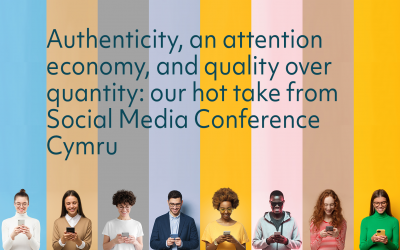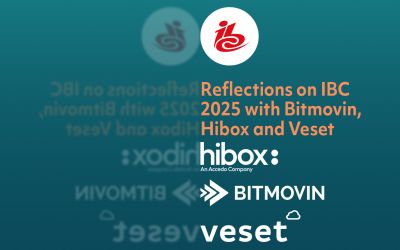After a brief hiatus in London, I was very excited to see the Media and Entertainment Mixer come back to its home in Bristol. Being based in the middle of West Wales, anything that reduces journey time is always welcome, but in particular the Bristol Media and Entertainment Mixer (BMEM) has got a few things right. Firstly, it is a really informal gathering where the industry can share laughs over beer and pizza, a refreshing change to the more formal events. Secondly, while it is relaxed, the content itself is extremely valuable and interesting, and I leave each event having learnt something new.
Now hurtling towards maturity and becoming a regular fixture in the calendar, this latest edition, which took place on 17th July, didn’t disappoint.
Do we really need 4K to watch Bake Off?

Helen Weedon
Managing Director, Radical Moves Ltd

Sustainability has been a hot topic in the industry for a few years now, but have we actually seen enough, if any real progress? Dom Robinson, of id3as, Lisa Collins from Dovetail Creative, and MTech Sport founder Matt Stagg, joined Faultline’s Tommy Flanagan to discuss whether the industry is just doing lip service and whether we really need 4K to watch Bake Off.
When asked whether traditional broadcasting is less sustainable than streaming, there was some disagreement but as Lisa pointed out the view is more that younger viewers are streaming versus watching traditional TV and ultimately streaming remains costly for the environment. It is clear we have a long way to go as an industry despite a number of initiatives. Dom expressed his own frustration even claiming that “most of the efforts are a complete waste of time.” He highlighted how too often the industry is focusing on the wrong things and not getting to the root of the problem.
When it comes to the question of watching Bake Off in 4K, Matt was quick to comment that there was very little point, especially for 8K, and especially as many channels aren’t even available in HD yet. Rich Welsh posed the question of how we deal with the fact that consumers can do 8K on Go Pros or even their phone now and have no idea that they are shooting in 8K or about the impact that has on sustainability. Matt and Lisa both agreed with this concern and highlighted the need for better education of end users to understand the impact. Most people in the room weren’t aware that all TVs have the option of filmmaker mode, which drastically reduces energy consumption.
However, Dom did caution that at times we put too much responsibility on the end users, and we need to remember our role as an industry. As Matt put it, the industry has a tendency to think that “someone else will solve it.” The panel discussed that there is currently no way to measure the end-to-end impact of a video stream. They also discussed that nothing will really change without the backing of industry leaders. Some of that will come naturally, as Lisa reminded us, with the introduction of CSR D reporting, which will be mandatory for larger European companies.

Can Live Streaming Be As Reliable as Live TV?
According to Keith Chow of Nokia it can. He presented a project kicked off by Nokia Bell Labs that is now being released as a product by Nokia. While the project isn’t new, the company had to wait for the right chipsets to be ready to make it into a reality. The technology uses RTP and can be used anywhere that is reachable by IP, whatever network it uses. It enables smooth, real-time streaming over multicast, with no delays and fast channel changes. And crucially it can be streamed over any public internet or managed network, even if the signal is not great.
While he did get in trouble with Tommy for having no less than 10 case studies, it was certainly interesting to see all the different streams that had been distributed using this technology, including a proof of concept that saw a football match streamed live to Vienna from Salzberg where fans were able to watch using XR as if they were in the stadium in Salzberg.

Smart TV/Connected TV – Framework Face-Off
By 2030, a fragmented 4.2 billion smart and connected TVs will be vying for attention—but beneath the growth lies a messy landscape of regional rifts, hardware churn, and fading form factors. For this discussion, Tommy was joined by Adam Nightingale of 3SS, Milan Đorđević of Red Cell Apps, 24i’s Stuart Huke, and BMEM co-founder, Joshua Seeley of 5V Video.
Tommy started the discussion by asking if this huge upsurge in connected devices was set to further fragment the market. As Adam pointed out, it depends whether they all will have a different OS too. Stuart agreed, citing that many use the same or similar OS. Milan did make the point however that the tech companies should be working together to limit that fragmentation.
Josh brought the discussion back to sustainability, fearing that with so many new devices hitting the market, what happens to those already in circulation, will they be resigned to landfill? This brought the discussion on to the subject of extending the life of legacy set-top-boxes, something there was general agreement is a good idea. As Stuart pointed out, a lot of people are happy with their legacy set-top-box, and it is hard to justify the change in those cases. It would be better to change the video experiences to fit those legacy devices, even if they are not as smooth as could be, as long as they are good enough for those customers. That comes back to the earlier discussion: what do consumers really want? The industry has a tendency to go all out on features that may not even make a difference.
However, Dom did mention that there is a point at which it becomes greener to swap out the devices as the energy usage might be higher than it could be with a new device. There are no real statistics to signal at what point that becomes better.
The panel concluded with the question as to the future of XR video experiences and whether we are there yet. While the panel was unanimously seeing it as a much longer term thing, I did put on my Accedo hat to highlight some of the experiences already being created, such as a project with Deutsche Telekom last year showcasing the potential for live football. I also mentioned the XR Sports Alliance, founded by Accedo along with HBS and Qualcomm. Much of the hesitation in the market comes down to the chicken and egg scenario we have with any new technology – people don’t create the experiences without good content and people don’t create good content without the means to show it. The XR Sports Alliance aims to combat that by bringing stakeholders together from across the ecosystem to accelerate experimentation and ultimately the adoption of XR for sports.
Join the Media & Entertainment Mixer in Amsterdam
While I was glad to see its return to Bristol, I’m equally excited for the first ever IBC MEM. While it will ditch the panels and focus on networking, it promises to be a must-attend event so make sure you register for your free tickets before they are snapped up.




